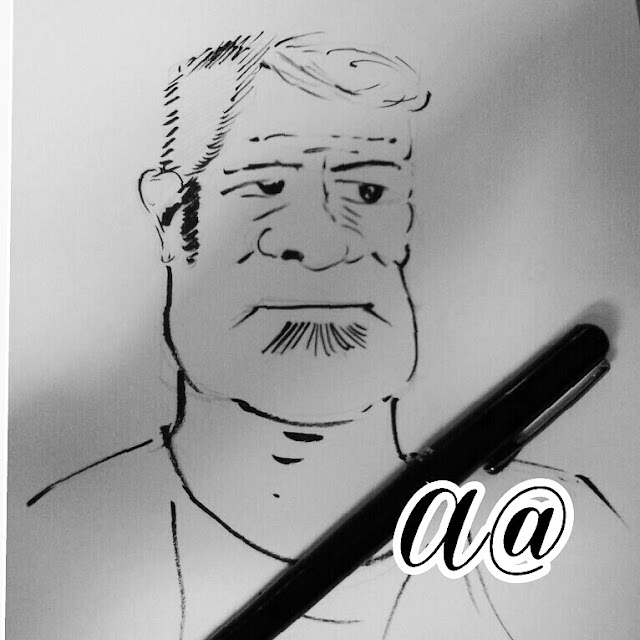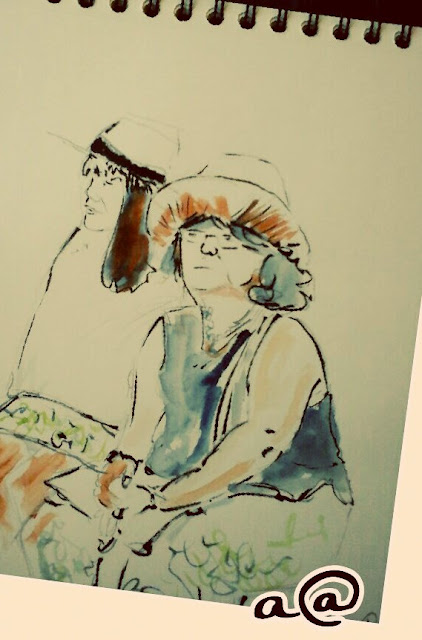Una colección de los últimos retratos.
domingo, 25 de octubre de 2015
miércoles, 14 de octubre de 2015
domingo, 26 de julio de 2015
Retratos en el matadero
La sesión de retratos de este domingo.
Han tocado varias parejas.
En el matadero de Madrid, un lugar para dibujar ideal.
martes, 7 de julio de 2015
domingo, 5 de julio de 2015
sábado, 6 de junio de 2015
jueves, 21 de mayo de 2015
jueves, 14 de mayo de 2015
lunes, 4 de mayo de 2015
Real Jardín Botánico de Madrid: 47th World Wide SketchCrawl. Segunda parte.
Están dando sombra al Estanque de Linneo.
Son un cedro y una secuoya. Utilicé el cuaderno de espiral tamaño cuartilla, el que utilizan los escolares y una pluma pincel de tinta en negro. Al trabajar con esta pluma, te permite dar más expresión al trazo, siendo muy útil a la hora de hacer arboles.
They are shading the pond Linnaeus.They are cedar and redwood. I used
spiral notebook sheet size, using school and a pen brush in black ink.Working with this pen, it allows you to give more expression to the stroke, be very useful when making trees.
sábado, 25 de abril de 2015
En el Jardín Botánico de Madrid: 47th World Wide SketchCrawl MADRID
Hoy ha tocado ir a dibujar al Real Jardín Botánico de Madrid: 47th World Wide SketchCrawl.
Me ha sorprendido la gran afluencia de público que había.
Dibujamos el lago que hay en el centro de del Jardín.
 Today has touched going to draw the Royal Botanical Garden of Madrid: 47th World Wide SketchCrawl.
Today has touched going to draw the Royal Botanical Garden of Madrid: 47th World Wide SketchCrawl.It had been a few years since I walked through the streets.
I was surprised by the large crowd that was there.
We draw the lake on the center of the Garden.
jueves, 23 de abril de 2015
PREMIO CERVANTES: Juan Goytisolo
Juan Goytisolo Gay. (Barcelona, 5 de enero de 1931). Novelista español. Nació en Barcelona, pero se considera un apátrida. Su madre murió en un bombardeo en la guerra civil española, cuando él tenía solo 7 años, una infancia difícil.
Estudia Derecho y en 1956 se instala en París, donde comienza a trabajar como asesor literario de la editorial Gallimard.
Ensayista y narrador, su obra quedo prohibida en España por la censura franquista desde 1963.
De estilo camaleónico, comprometido con el mundo contemporáneo, de la España actual. Colaborando en la prensa en el diario El País, llegando a ser corresponsal de guerra en Chechenía y Bósnia.
Vive entre Marraquech, París, Estados Unidos y España. Imparte clases e literatura en universidades de California, Boston y Nueva York.
Juan Goytisolo Gay. (Barcelona, January 5, 1931). Spanish novelist. Born in Barcelona, but is considered a stateless person. His mother died in a bombing in the Spanish civil war, when he was only seven years, a difficult childhood.
He studied law and in 1956 moved to Paris, where he began working as a literary adviser Gallimard.
Essayist and writer, his work estubo banned in Spain by Francoist censorship since 1963.
From chameleon style, committed to the contemporary world, the current Spain. Collaborating in the press during daily El País, becoming a war correspondent in Chechnya and Bosnia.
He lives in Marrakesh, Paris, United States and Spain. He lectures and literature at universities in California, Boston and New York.
miércoles, 22 de abril de 2015
Detalle de la fachada de la Universidad de Alcalá. Premio Cervantes
Detalle de la fachada de la Universidad de Alcalá. En concreto, el escudo del emperador Carlos, del que destaca el águila bicéfala y cartelas con el lema ‘Plus Ultra’. Justo encima, aparece el Dios Padre y Creador, que gobierna el mundo con la
mano derecha y sostiene la Tierra con la izquierda.
Si queréis saber más de la fachada: http://www.diariodealcala.es/actualidad/cultura/item/8646-los-secretos-de-la-fachada-de-la-universidad-de-alcal%C3%A1
Este próximo jueves se entregaran el Premio Cervantes.
sábado, 18 de abril de 2015
Circulo de Contribuyentes
Esta fachada de ladrillo de uno de los edificios más emblemáticos de Alcalá de Henares.
Hoy al dibujarlo he descubierto lo complicado de su diseño.
miércoles, 18 de marzo de 2015
domingo, 15 de marzo de 2015
La fuente del parque.
En lo cotidiano esta a veces un modelo irresistible.
La fuente quieta, decía:
Dibujame, dibujame.
Listo.
jueves, 19 de febrero de 2015
En la plaza Palacio.
En la plaza de palacio hay una fuente pequeña.
Por las mañanas, refleja la luz y el agua. Su sonido acompaña el movimiento.
Al fondo, hay varias casas antiguas que cierran la plaza.
domingo, 1 de febrero de 2015
Técnicas de acuarela. Mr. Otter Art Studio
http://www.youtube.com/watch?v=K-KYHJriivw&feature=youtube_gdata_player
martes, 13 de enero de 2015
De camino a la Laguna de Peñalara
De camino a la Laguna de Peñalara, esta acuarela de tamaño Dina A4, 100g/m2, la he dibujado tomando como referencia una foto que hice estos días en un paseo hasta la Laguna Grande de Peñalara, el comino estaba helado, pero con paciencia y prudencia llegue.
El paisaje estaba helado, los pino tenían témpanos de hielo colgando de sus ramas y alguna vez todo en mi cabeza el hielo, con suerte que este era pequeño.
jueves, 1 de enero de 2015
La Magistral Catedral de Alcalá de Henares
 | ||||||
| Torre de la Magistral Catedral de Alcalá de Henares |
La historia de esta construcción comienza desde el siglo IV. Época en la que se persiguió a los cristianos, en este lugar se ajusticio a los cristianos complutenses.
En el siglo V, época visigoda, se sabe que había una capilla que albergaba los restos de los mártires (Justo y Pastor). En el siglo VIII, dominación árabe, los restos del los ajusticiados fueron trasladados a un valle de Huesca y no regresan a Alcalá hasta el S. XVI.
En los años 1500, se construye la iglesia gótica, siendo la única en la Comunidad de Madrid.
El
Cardenal Cisneros consiguió para la Iglesia de los Santos Niños el
título de “Magistral” en 1519.
Desde hace unos años, 1991, el templo comparte este título con el de “Catedral”, al ser la sede del Obispo diocesano.
Desde hace unos años, 1991, el templo comparte este título con el de “Catedral”, al ser la sede del Obispo diocesano.
La torre fue construida en 1527, finalizada en el siglo XVII, es rematada por un chapitel de influencia flamenca.
La altura de la torre es de 62,05 m, la dimensiones de su planta son 12x12m, su fachada es de piedra.
Desde esta torre en la guerra civil, se instalan ametralladoras.
El 21 de julio de 1936, sufre incendio el templo y posteriormente saqueo, hasta 1947 no comienza a reconstruirse, abriéndose al público en 1975.
En 1991 al ser Alcalá diócesis comienza su reforma definitiva concluyendo en 20 de febrero de 1999.
En la actualidad, se hacen visitas a la torre para poder presenciar la ciudad desde sus alturas. En ella crían varias parejas de cigüeñas.
The history of this construction starts from the fourth century. Time when Christians were persecuted, in this place he executed them at the Complutense Christians.
In the V century Visigoth period, it is known that there was a chapel housing the remains of the martyrs (Justo and Pastor). In the eighth century, Arab domination, the remains of the executed were transferred to a valley of Huesca and do not return to Alcalá until S. XVI.
In the 1500s, the Gothic church is built, the only in the Community of Madrid.
Cardinal Cisneros got to the Church of the Holy Child the title of "Master" in 1519.
For years, 1991, the temple shares this title with that of "Cathedral", being the seat of the diocesan bishop.
The tower was built in 1527, completed in the seventeenth century, is topped by a spire Flemish influence.
The height of the tower is 62.05 m, the size of the plant are 12x12mm, its facade is made of stone.
From this tower in the civil war, guns are installed.
On July 21, 1936, suffers fire temple and then plunder, until 1947 does not begin to rebuild, opened to the public in 1975.
In 1991 when Alcalá diocese reform begins its final concluding February 20, 1999.
Currently, visits are made to the tower to witness the city from its heights. It raised several pairs of storks.
The history of this construction starts from the fourth century. Time when Christians were persecuted, in this place he executed them at the Complutense Christians.
In the V century Visigoth period, it is known that there was a chapel housing the remains of the martyrs (Justo and Pastor). In the eighth century, Arab domination, the remains of the executed were transferred to a valley of Huesca and do not return to Alcalá until S. XVI.
In the 1500s, the Gothic church is built, the only in the Community of Madrid.
Cardinal Cisneros got to the Church of the Holy Child the title of "Master" in 1519.
For years, 1991, the temple shares this title with that of "Cathedral", being the seat of the diocesan bishop.
The tower was built in 1527, completed in the seventeenth century, is topped by a spire Flemish influence.
The height of the tower is 62.05 m, the size of the plant are 12x12mm, its facade is made of stone.
From this tower in the civil war, guns are installed.
On July 21, 1936, suffers fire temple and then plunder, until 1947 does not begin to rebuild, opened to the public in 1975.
In 1991 when Alcalá diocese reform begins its final concluding February 20, 1999.
Currently, visits are made to the tower to witness the city from its heights. It raised several pairs of storks.
Suscribirse a:
Comentarios (Atom)

































